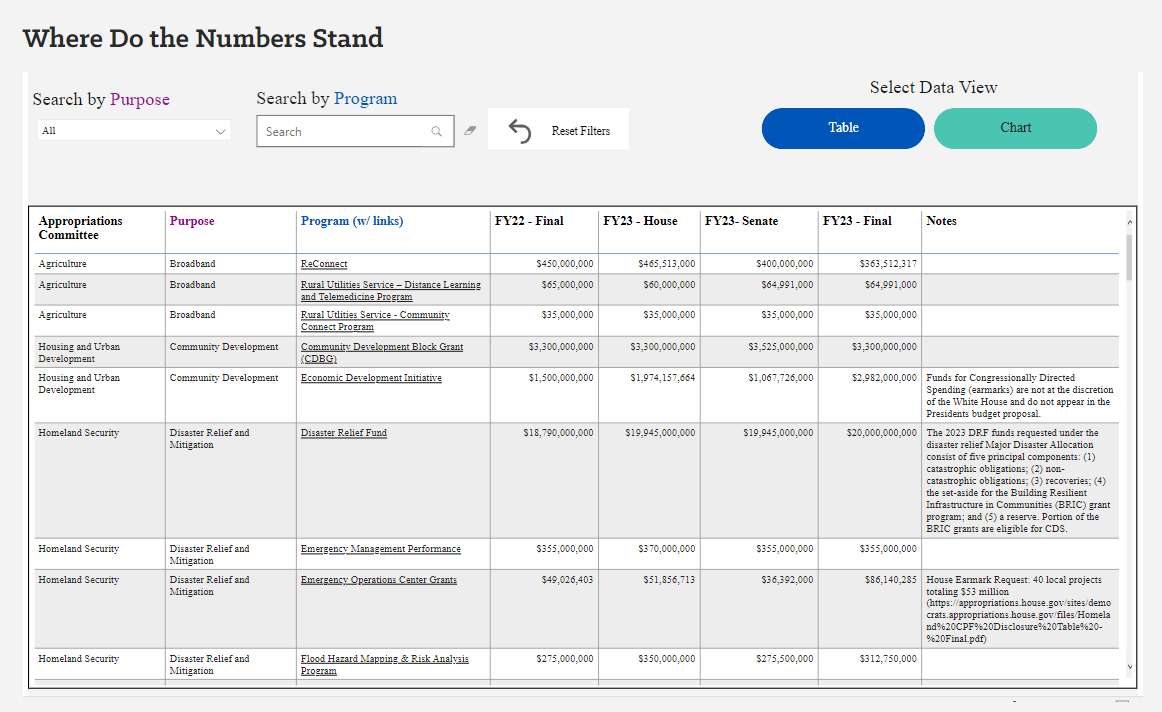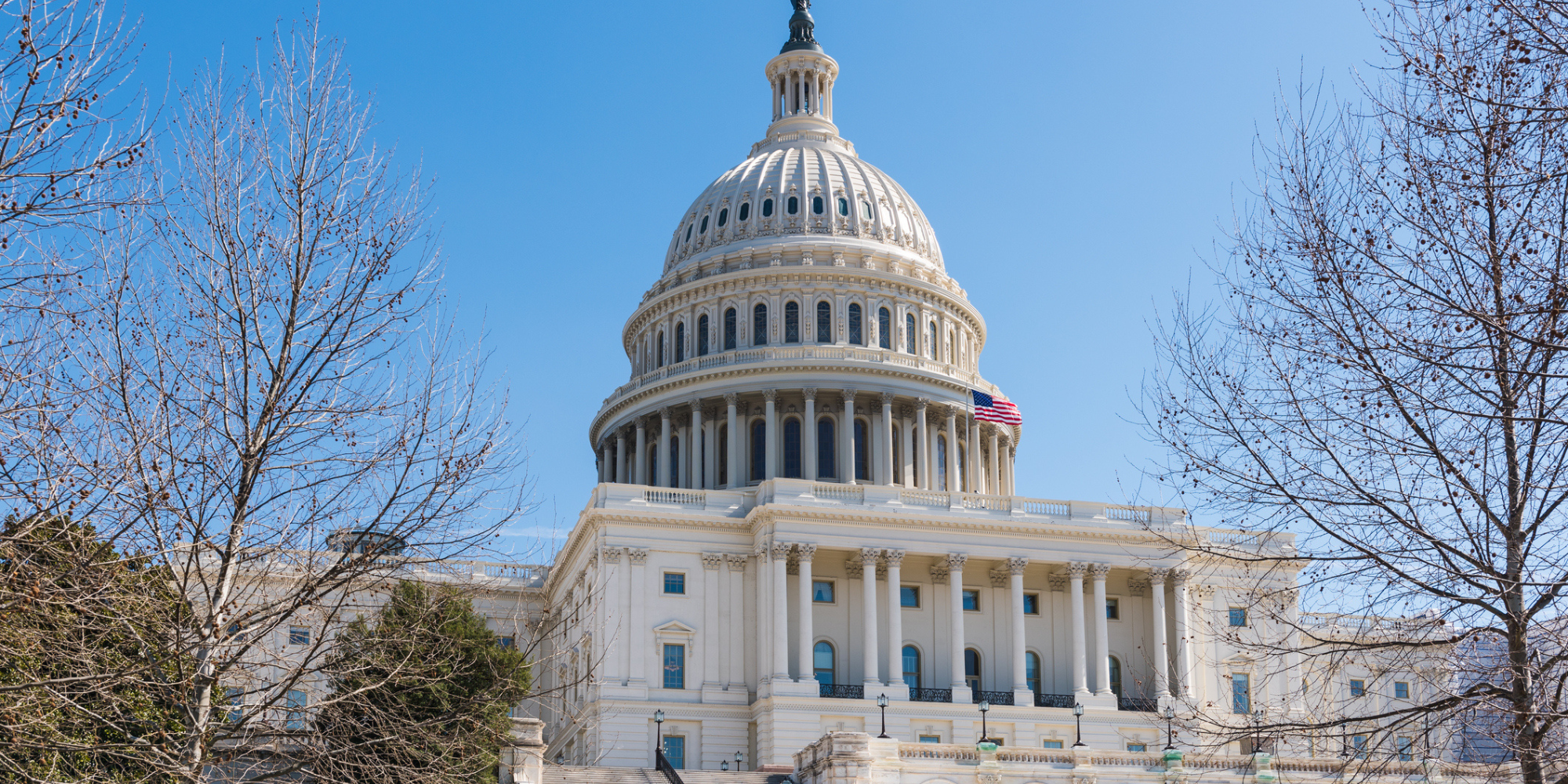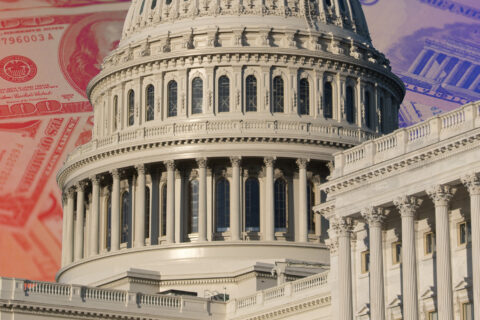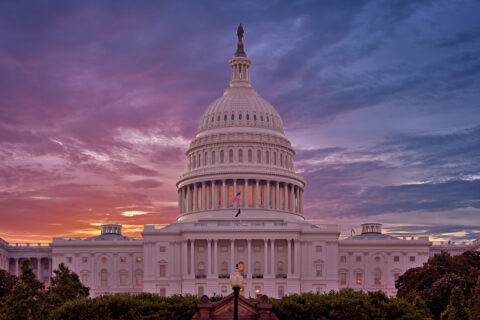On December 29, 2022, President Biden signed a $1.7 trillion-dollar omnibus spending bill that officially avoided a government shutdown and included a number of programs and priorities important to local governments. This bipartisan spending bill outlines the final federal budget for Fiscal Year 2023 (FY23) and sets the funding levels for each federal agency.
One of the significant provisions in the final spending bill was actively supported by NLC and provided more flexibility to each city’s current funding from the American Rescue Plan Act State and Local Fiscal Relief Funds (SLFRF), also known as ARPA Flex. You can read more about the APRA Flex provisions included in the final spending bill in this blog.
NLC’S Federal Budget Tracker provides a visual analysis of the annual funding levels for programs important to local governments. This year’s tracker compares the Fiscal Year 2022 (FY22) funding levels approved by Congress, the FY23 numbers first proposed and approved by the House, the FY23 numbers then countered and approved by the Senate, and the final FY23 funding levels approved by Congress and signed into law by President Biden. The “Chart” view of the tracker compares the FY22 final numbers with the FY23 final numbers for relevant local government programs or spending categories.
For the most part, funding levels for local priorities in the FY23 budget have been maintained or incrementally raised compared to the FY22 budget. However, some programs did see a marginal or larger decrease in funding, with many of these areas relating to infrastructure. Other areas, such as economic development, housing, water infrastructure, and law enforcement/public safety, saw an increase in funding levels for many related programs. You can find a more extensive comparison of FY22 and FY23 final numbers at the dashboard link above.

Transportation
The FY23 budget includes funding for a number of transportation programs significant to cities that were authorized under the five-year Infrastructure Investment and Jobs Act (IIJA), also known as the Bipartisan Infrastructure Law.
The Rebuilding American Infrastructure with Sustainability and Equity (RAISE) grants received $800 million in FY23, which is $25 million more than the FY22 enacted level.
The bill, together with the Bipartisan Infrastructure Law advance appropriations, provides $4.2 billion for Capital Investment Grants (CIG), $387 million more than the FY22 enacted level.
Additionally, $25 million is again included in this year’s budget to support the technical assistance and capacity building with the Thriving Communities program, so cities of all sizes can get the support they need to access federal infrastructure funds.
Finally, this year the Essential Air Service Program received $354 million to support regional connection flights across the country.
Housing and Homelessness
Local governments can expect overall increases in housing programs in 2023. Funding for Housing Choice Vouchers, which help low-income renters, were increased to ensure all existing vouchers would continue to be funded for the year. The bill also provides an additional 12,000 rental assistance vouchers specifically targeted to residents at high risk of homelessness.
The Homeless Assistance Grants were increased, including $75 million to finance new permanent supportive housing for people experiencing homelessness, while the HOME program for construction of affordable housing and CDBG grants were both funded at the same level as last year. The CDBG allocation also includes $85 million to pilot a new competitive grant program to incentivize and award local governments to modernize zoning ordinances and land use policies for the purpose of developing affordable housing. The bill leaves it to the U.S. Department of Housing and Urban Development (HUD) to figure out the details of how the new program will work.
The bill also nearly doubles funding for earmarks that generally support hard-to-finance local projects that have support from members of Congress to $2.9 billion.
Economic Development
Highly flexible Economic Development Administration (EDA) grants to support local and regional economic development efforts continue to be funded at high levels, signaling the growing confidence of Congress in EDA and their grantees thanks to the success of the agencies COVID-19 response.
EDA received nearly $500 million for FY23. Cities and towns are eligible for EDA grants and localities should reach out to their EDA regional offices if they are interested in applying.
Broadband and Telecommunications
Most new broadband funding authorized by Congress in 2022 was included in the Bipartisan Infrastructure Law. However, several key appropriations were made to support the administration of these broadband programs, as well as an extension of rural broadband programs.
The National Telecommunications and Information Administration, which is administering the largest-ever one-time influx of federal grant dollars for broadband and digital equity, received an increase for FY23 from $50 million to $62 million. This funding will help the agency hire the additional staff needed to stand up and administer these large new grant programs.
The U.S. Department of Agriculture’s ReConnect rural broadband pilot program received a new $363.5 million tranche of funding. While this is a decrease from the $450 million appropriated for FY22, the FY23 total likely reflects lawmakers’ recent passage of programs targeted at rural broadband through the bipartisan infrastructure law.
The FY23 appropriation for rural broadband also includes congressionally directed spending requests for specific broadband projects.
Water Infrastructure
The final FY23 appropriations provide level funding compared to FY22 for both the U.S. Environmental Protection Agency (EPA) Clean Water and Drinking Water State Revolving Fund (SRF) at $1.629 billion and $1.126 billion respectively. This funding, however, includes $863 million and $609 million in Congressionally Directed Spending (earmarks) respectively. For both the Clean Water and Drinking Water SRF, this Congressionally Directed Spending represents over 50% of the total appropriation.
Under the U.S. Department of Agriculture, the Rural Utilities Service Water and Waste Disposal Program also received near-level funding at $1.42 billion for FY23.
Several key EPA water infrastructure grant programs are included in the FY23 appropriations, but many that were authorized as part of the Bipartisan Infrastructure Law are not funded. The FY23 appropriations package provides a slight increase in funding for sewer overflow control grants ($50 million), reducing lead in drinking water grants ($25 million), drinking water infrastructure resilience and sustainability grants ($7 million) and small and disadvantaged communities grants ($30.2 million).
Energy Efficiency and Renewable Energy
Reducing greenhouse gas emissions and investing in clean energy are key priorities of the Bipartisan Infrastructure Law and the Inflation Reduction Act, and the FY23 appropriations continue toward those goals. The U.S. Department of Energy Office of Energy Efficiency and Renewable Energy is funded at $3.46 billion, compared to $3.2 billion in FY22.
Additionally, under the U.S. Department of Health and Human Services, the Low Income Home Energy Assistance Program received $5 billion in funding, compared to $3.8 billion in FY22, to help households with heating and cooling energy costs.
Environmental Programs
EPA environmental programs see an uptick in funding in FY23, including the Brownfields program at $100 million (compared to $92 million in FY22).
The Bipartisan Infrastructure Law provided first-time funding to support post-consumer material management infrastructure and recycling efforts, now known as the Solid Waste Infrastructure for Recycling (SWIFR) grant program. The FY23 appropriations provide $6.5 million for SWIFR grants.
Law Enforcement and Public Safety Grants
As communities are facing increased violence, Congress has made it a priority to invest in programs to reduce violence.
There was a significant increase in law enforcement grant funding, including an additional $96 million for Byrne Justice Assistance Grants, $152 million more for COPS Hiring Grants, $10 million more for the Second Chance Act and an additional $82 million more for school violence prevention.
Unfortunately, some programs did see a decrease in funding levels, including funding for juvenile justice programs, Federal Emergency Management Agency (FEMA) grants for State and Local Homeland Security Grants and the Urban Area Security Initiative (UASI).
Disaster Mitigation and Preparedness Funding
Congress increased disaster mitigation and preparedness funding by more than $1.2 billion for FY 2023. This funding continues to build on the funding approved in the Bipartisan Infrastructure Law to make communities more resilient to natural disasters.
Workforce Development
With an increasing national focus on the need to ensure a skilled workforce to meet growing labor demands, the FY23 appropriations package includes increased funding for foundational workforce and postsecondary programs.
The Workforce Innovation and Opportunity Act, which funds the bulk of the federal government’s 43 employment and training programs, was funded at $4.141 billion (compared to $3.880 billion in FY22).
Additionally, the career, technical and adult education program funding also received a slight increase to be funded at $2.191 billion (compared to $2.1 billion in FY22).
Of note is the newly authorized RECOMPETE Pilot Program that will be operated out of the Department of Commerce. This program received an initial appropriation of $159 million that will allow the agency to begin to plan for the rollout of this 10-year program targeted at local economic development needs and increasing employment rates.
Substance Use and Mental Health
The FY23 appropriations package provides $4.9 billion to combat the opioid epidemic and importantly gives flexibility to use opioid response funds across programs. The bill includes $445 million (an increase from $185 M million FY22) for the Comprehensive Opioid, Stimulant, and Substance Abuse Program, $95 million for Drug Courts (up from $88 million in FY22) and $45 million (up from $40 million in FY22) for Mentally Ill Offender Act/Mental Health Courts.
The FY23 appropriations bill provides $5.27 billion for mental health prevention, treatment and research. This includes $512 million for the Substance Abuse and Mental Health Services Administration (SAMHSA) suicide prevention activities, including $439.6 million for the recently launched 9-8-8 Suicide Lifeline.
Early Childhood and K-12 Education
Funding for the youngest residents of our nation’s cities, towns and villages also saw an increase in the FY23 appropriations package, including programs that local leaders rely upon to support their local educational infrastructure.
At the Department of Education, the 21st Century Community Learning Centers program was level-funded at $1.3 billion, while the Full-Service Community Schools program was significantly increased from $30 million to $150 million. Through the Department of Health and Human Services, Head Start was funded at $12 billion (up from $11.03 billion in FY22), the Child Care and Development Block Grant was funded at $8 billion (up from $6.165 billion in FY22) and the Preschool Development Grant program was funded at $315 million (up from $290.0 million in FY22).
Stay Updated
Want the latest federal updates in your inbox? Sign up for our Federal Advocacy Newsletter.










